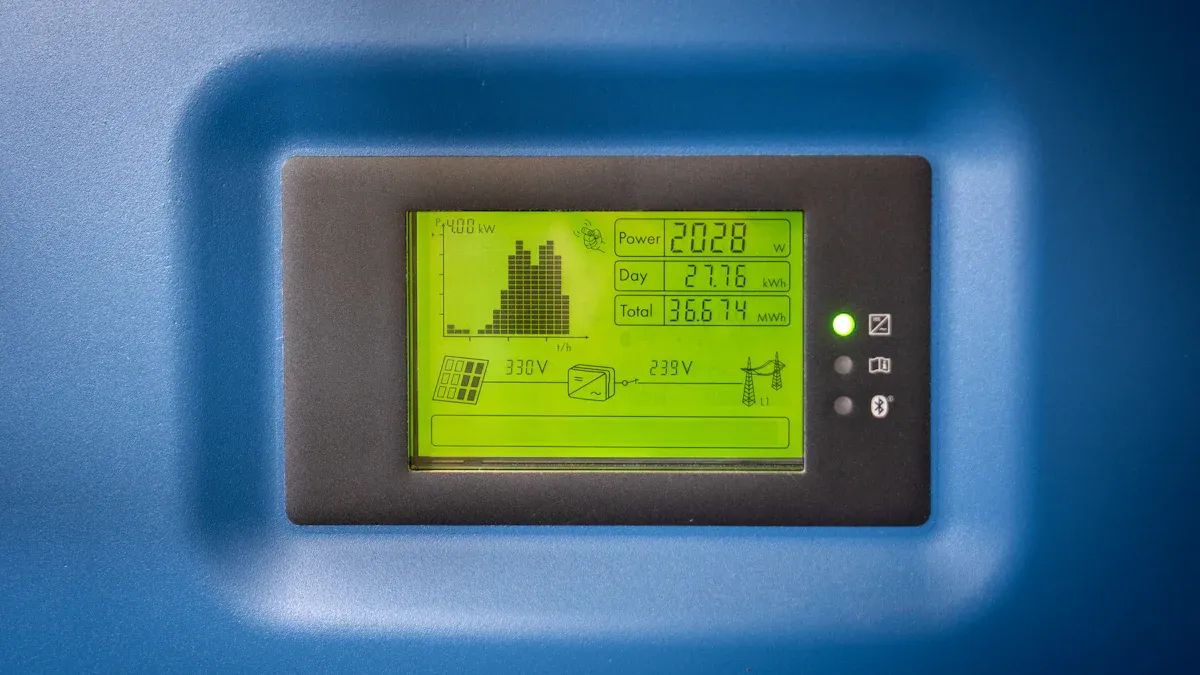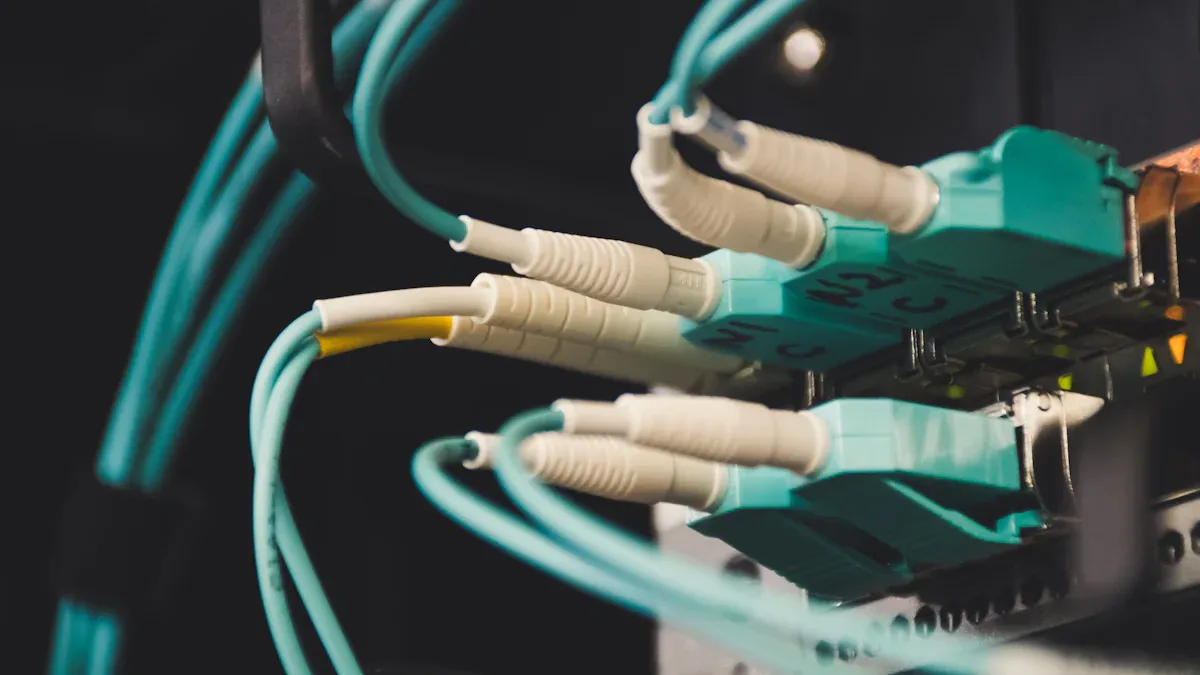Features and Advantages of Modern Telecom Rectifier Systems

A rectifier system for telecom plays a crucial role in powering telecom networks by converting alternating current (AC) into direct current (DC). This ensures telecom equipment receives a steady and reliable power supply, which is essential for maintaining stable telecom systems.
The demand for the rectifier system for telecom is growing rapidly. By 2025, these systems are projected to account for 48.15% of the telecom power market. They are highly efficient, helping to conserve energy and safeguard equipment from power fluctuations. Modern rectifier system designs for telecom boast over 98% efficiency, significantly reducing energy waste and operational costs.
Key Takeaways
Telecom rectifiers change AC power into DC power. This helps telecom devices like routers and switches work properly.
New rectifiers are over 98% efficient. They save energy, cut costs, and are good for the environment and your wallet.
Special features like backups and safety tools keep networks working. They stop downtime and protect devices from power problems.
Flexible designs make upgrades easy as networks grow. This keeps systems working well with new technology.
Checking and caring for rectifiers often makes them last longer. It also lowers repair costs and keeps them reliable.
Understanding Telecom Rectifier Systems
Definition and Purpose
Telecom rectifier systems are key parts of telecom networks. They change alternating current (AC) from the grid into direct current (DC). Telecom devices like routers and switches need DC to work. Without this, they cannot run properly or efficiently.
These systems give a steady power supply to telecom equipment. They also protect devices from power problems that can cause damage. Modern designs, like those with Superjunction MOSFETs, are very efficient. They can reach up to 98.5% efficiency. This saves energy and lowers costs, making them very important for telecom systems.
Role in Telecommunications Networks
Telecom rectifier systems help keep telecom networks running smoothly. They provide steady DC power for connected devices. If power fails, backup systems turn on to avoid service breaks. Safety features stop over-voltage and short circuits, protecting your equipment.
Efficient rectifiers save energy and reduce costs. They also support eco-friendly operations by cutting energy waste. Advanced designs fit well with telecom systems, improving performance. They ensure networks work even in tough situations.
Feature | Benefit | Impact on Reliability |
|---|---|---|
Backup systems | Work during power outages | Prevents service interruptions |
Protection features | Stops power surges and damage | Keeps equipment safe |
Steady DC power | Supplies constant power | Ensures smooth operation |
Using telecom rectifier systems improves network performance. They protect equipment and keep communication services running without breaks.
How Telecom Rectifier Systems Work
Changing AC to DC Power
Telecom rectifier systems change alternating current (AC) into direct current (DC). This helps telecom devices, which need DC power, work smoothly. Advanced tools like CoolGaN™ and CoolSiC™ make this process very efficient. They can reach over 99% efficiency at half load. This reduces wasted energy and boosts system performance.
These systems have features like high power density and steady efficiency. They are also very reliable and need little maintenance. For example, modern systems can be 99% efficient and are small in size. This makes them great for outdoor use, where natural cooling is common. Below are some key features:
Feature | Description |
|---|---|
Efficiency | Up to 99% |
Power Density | 73 W/in³ |
Reliability | Built to last and lower maintenance costs |
Environmental Operation | Works well outdoors with natural cooling |
Load Efficiency | Stays efficient from 30% to 100% load |
Typical Lifetime | Can run full-time for 15 years |
By wasting less energy, these systems save money and help the environment. They lower the carbon footprint of telecom operations.
Working with Telecom Power Systems
Telecom rectifier systems fit easily into telecom power setups. They follow safety and quality rules like EN60950 and UL950. These rules ensure safe operation by setting isolation voltage limits. EN55022 controls electromagnetic interference, keeping systems running smoothly.
Efficiency is a big focus for these systems. High-efficiency rectifiers, over 96%, cut energy use and save money. This is vital for large telecom networks, where small inefficiencies can cost a lot. Here are some key details:
Metric | Value |
|---|---|
Total systems deployed | 500,000 |
Total rectifier modules | 2,400,000 |
Efficiency of rectifier modules | Approaching 97% |
Future efficiency goal | Approaching 98% |
These systems can grow with your network. They connect well with current setups, ensuring reliable and smooth service.
Features of Modern Telecom Rectifier Systems

Energy Efficiency and Optimization
Modern telecom rectifiers are made to save energy and cut costs. They change AC power to DC with up to 97.83% efficiency at 277 VAC. This means very little energy is wasted, making them eco-friendly for telecom use.
Smart energy systems adjust power based on what’s needed. They manage power in real time to avoid waste. Digital controls help parts work better together. Energy-saving modes use less power when demand is low, helping the environment.
Metric | Value |
|---|---|
Peak Efficiency | 97.83% |
Voltage for Peak Efficiency | 277 VAC |
Full Load Efficiency (min) | Above target |
These rectifiers can work with solar panels, cutting down on regular energy use. Automated systems watch and adjust power use as needed. This lowers energy bills and reduces the carbon footprint of telecom systems.
Advanced Monitoring and Remote Management
Modern rectifiers let you track performance like voltage and temperature live. Remote tools allow you to control and set up rectifiers from anywhere. This keeps your system running smoothly.
Problems can be fixed before they get worse. Alerts warn you about issues like overheating or power changes. This helps avoid downtime and keeps your network reliable.
Remote tools also make maintenance easier. You can update software or check for problems without being there. This saves time and money by reducing on-site visits.
Scalability and Modular Design
Modular designs let you grow your system as your needs change. You can add or replace parts to match your power needs. This makes the system flexible and easy to upgrade.
Feature | Description |
|---|---|
High Reliability | If one part fails, others keep working, avoiding full system failure. |
Scalability | Add or replace parts as needed for more power. |
Reduced Downtime | Fix one part without shutting down the whole system. |
Continuous Operation | The system keeps running even if a part breaks. |
This design also cuts downtime during repairs. You can fix one part without stopping the whole system. Even if one module fails, the rest keeps working. These features make modular rectifiers perfect for telecom networks needing constant operation and flexibility.
Redundancy and Protection Mechanisms
Modern telecom rectifier systems include backup and safety features. These ensure your equipment stays safe and your network keeps running. Such features are vital for reliable telecom networks, especially where downtime is unacceptable.
Redundancy for Uninterrupted Operation
Redundancy means having backups ready if something breaks. If one part fails, another takes over. This keeps your telecom network running smoothly. For instance, if a rectifier module stops, others fill in the gap. This design keeps efficiency high and lowers the chance of failure.
Benefits of redundancy include:
Continuous Operation: The network works even if parts fail.
Reduced Downtime: Replace broken parts without stopping the system.
Scalability: Add more parts to increase power and reliability.
Protection Mechanisms for Equipment Safety
Protection features guard your equipment from power problems. They control power to stop damage from voltage spikes, overheating, or short circuits. Advanced tools like surge protection and heat control keep devices safe in all conditions.
Common protection features include:
Overvoltage Protection: Stops harm from sudden voltage jumps.
Short Circuit Protection: Cuts power during short circuits to protect devices.
Thermal Protection: Watches temperature to prevent overheating issues.
Tip: Check your system’s safety settings often to keep it working well.
Why Redundancy and Protection Matter
These features are key to keeping your telecom network strong. Redundancy handles unexpected failures, while protection shields equipment from power issues. Together, they improve efficiency, cut repair costs, and give you peace of mind.
Choosing a rectifier system with strong redundancy and safety features ensures your network stays reliable and efficient, even in tough situations.
Benefits of Telecom Rectifier Systems

Better Network Reliability
Telecom rectifier systems make networks more reliable. They provide steady power, even during outages or power issues. This keeps communication services running without interruptions. Modern rectifiers have advanced features like backups and safety tools. These prevent failures and protect your equipment.
Experts check reliability using strong methods. They study past failures from reports and tests. Standards like MIL-HDB-217F guide how to measure stress on parts. These checks ensure rectifiers meet telecom network needs.
Key benefits of better reliability include:
Uninterrupted Service: Backup power keeps networks running during outages.
Equipment Protection: Safety tools stop damage from power surges or short circuits.
Improved Performance: Steady power helps devices work their best.
A reliable rectifier system reduces downtime and keeps services consistent.
Saving Money and Energy
Modern telecom rectifiers are very efficient. They save energy and lower costs by wasting less power. These systems turn AC into DC with little energy loss. Smart tools manage power use to avoid waste.
Studies show big savings with advanced technology. For example, liquid cooling in data centers cut energy use by 43%. AI tools reduced server energy by 20%. NTT Group’s IOWN tech uses 100 times less energy than older methods.
Initiative | Description | Energy Savings |
|---|---|---|
KDDI Corporation, Mitsubishi Heavy Industries, NEC | Liquid cooling for edge computing data center | 43% reduction |
Intel and KDDI Corporation | AI to control server traffic | Up to 20% reduction |
NTT Group | IOWN technology for GHG emissions reduction | 100x lower energy consumption |
These examples show how rectifiers save money and help the planet. Choosing efficient rectifiers lowers bills and supports eco-friendly goals.
Longer Equipment Life
Telecom rectifiers help devices last longer. They give clean, steady power, reducing wear on equipment. Power surges, overheating, and voltage changes can break devices. Rectifiers with safety tools stop these problems.
For example, overvoltage protection blocks sudden power spikes. Thermal protection stops overheating by controlling temperature. These features save money on repairs and replacements.
Benefits of longer equipment life include:
Lower Maintenance Costs: Fewer repairs save money.
Better Performance: Well-kept devices work more efficiently.
Eco-Friendly: Long-lasting devices create less electronic waste.
Investing in rectifiers with strong safety features protects your equipment and ensures it works well for years.
Flexibility and Adaptability for Future Growth
Modern telecom rectifiers are built to grow with networks. Their flexible design helps meet changing telecom needs. As networks expand, these systems scale easily. They ensure smooth service and top performance.
Modular Designs for Scalability
A key feature of modern rectifiers is modular design. You can add or swap modules as power needs grow. For example, expanding networks can use extra modules without replacing the system. This keeps your investment ready for the future.
Main benefits of modular designs include:
Easy Upgrades: Add modules to handle more power needs.
Less Downtime: Fix broken parts without stopping the system.
Cost Savings: Expand gradually, avoiding big upfront costs.
Tip: Pick plug-and-play rectifiers for simpler upgrades later.
Supporting Emerging Technologies
Modern rectifiers now support new tech like hybrid DC power systems. These mix solar energy with traditional batteries. This boosts efficiency and supports eco-friendly goals.
Future-ready rectifiers also work in green buildings and EV setups. Their flexibility makes them useful in many industries. This ensures they stay valuable for telecom networks.
Market Trends and Growth Potential
The telecom power market is growing fast. It’s expected to rise by 8.30% yearly from 2025 to 2033. This shows the need for flexible power solutions. Below is a market snapshot:
Market Segment | CAGR (%) | Timeframe |
|---|---|---|
Telecom Power Systems Market | 8.30% | 2025-2033 |
Other trends include:
More use of hybrid DC systems with solar and batteries.
Focus on modular, scalable systems for flexibility.
Growth in green building and EV infrastructure applications.
Benefits of Flexibility and Adaptability
Flexible rectifiers offer many advantages. They keep networks reliable as demands grow. High efficiency and scalability cut costs and support green goals. Backup power ensures service during outages.
The future of telecom rectifiers is bright. Modular, plug-and-play designs will improve scalability and performance. Choosing adaptable systems prepares your network for long-term success.
Choosing the Right Rectifier System for Telecom
Power Capacity and Requirements
It’s important to know your network’s power needs. Check the total power used by your telecom devices like routers and switches. Think about peak power needs to handle sudden increases in usage. Pick a rectifier with more capacity than you currently need. This gives room for growth and avoids overloading.
For example, using 80% of the rectifier’s capacity works well. It leaves extra space for unexpected power demands. Overloading can cause overheating and shorten the rectifier’s life. Always match the rectifier’s power output to your network’s needs for the best results.
Energy Efficiency Ratings
Energy efficiency helps save money and protect the environment. Many modern rectifiers are over 96% efficient. This means they waste very little energy when changing AC to DC power. Look for systems with certifications like ENERGY STAR. These show the rectifier meets high-efficiency standards.
Efficient rectifiers also produce less heat. This reduces the need for extra cooling, saving more money. By choosing a high-efficiency rectifier, you lower energy bills and support eco-friendly telecom operations.
Compatibility with Existing Systems
Make sure the rectifier works with your current setup. Modern rectifiers fit easily with systems like EPS inverters and smart battery management tools. They often use a standard 19-inch rack design, making them easy to install. They also handle different power sources well.
Remote monitoring lets you check performance and fix problems from anywhere. The table below shows key features of modern rectifiers:
Feature | Description |
|---|---|
Design | Standard 19-inch rack-mount design with advanced power control. |
Power Inputs | Handles a wide range of power sources for flexibility. |
Intelligent Battery Management | Includes smart battery management for better performance. |
Remote Monitoring | Allows remote tracking for easier maintenance. |
Compatibility | Works with EPS inverter systems for reliable operation. |
Choosing a rectifier with these features ensures smooth setup and dependable performance for your telecom network.
Scalability for Future Network Needs
Scalability is a key feature of modern telecom rectifiers. As networks grow, power systems must expand easily. Modern rectifiers are built to grow without replacing the whole system. Their modular design lets you add parts as your network grows.
With modular systems, you can increase power step by step. For example, if more power is needed, just add modules. This saves money and avoids long downtimes. It also keeps your system ready for new technologies and higher demands.
Scalable rectifiers also work with renewable energy like solar power. This reduces dependence on traditional grids and supports green goals. Using these systems helps save energy and protect the environment.
Another benefit of scalability is reliability. If one part breaks, others keep working. This ensures no service interruptions during repairs or failures. You can also upgrade parts without stopping the whole system.
When choosing a rectifier, pick one that grows with your network. Scalable systems save costs, reduce downtime, and prepare for future needs. They are a smart choice for evolving telecom networks.
Telecom rectifier systems are crucial for keeping networks reliable. They provide steady power, protect devices, and adjust to future needs. The industry is growing due to 5G, green energy, and tailored solutions.
Segment Type | Details | Growth Rate |
|---|---|---|
Type | Factors driving or slowing growth | Positive/Negative |
Application | Industry areas with opportunities | Expected growth |
The telecom power market is expected to rise from $4.2 billion in 2023 to $6.6 billion by 2028, growing at a 9.4% annual rate. Understand your network’s needs to pick a system that supports your goals and eco-friendly growth.
FAQ
What is the lifespan of a telecom rectifier system?
Telecom rectifiers usually last 10 to 15 years. Regular maintenance helps them work longer. Replace worn parts on time to avoid issues. Follow the manufacturer’s instructions for the best performance.
How do I choose the right rectifier system for my network?
First, check your network’s power needs. Pick systems that save energy and grow with your setup. Make sure they fit with your current equipment. Choose one that can handle future demands without big changes.
Can telecom rectifier systems work with renewable energy sources?
Yes, many rectifiers work well with solar panels. They help reduce the use of regular power grids. Look for systems that support hybrid DC power setups for eco-friendly use.
How do redundancy features improve network reliability?
Redundancy means having backups ready if something breaks. If one part fails, another takes over. This keeps your network running without interruptions and protects your equipment.
Are telecom rectifier systems environmentally friendly?
Modern rectifiers waste less energy and lower carbon emissions. Many work with renewable energy sources like solar power. ENERGY STAR-certified systems are even better for the environment.
Tip: Keep your rectifier system in good shape with regular checks. This improves efficiency, lasts longer, and supports green goals.
See Also
Essential Insights Into Telecom Power Supply Characteristics
Tips for Guaranteeing Dependable Power Supply in Telecom Units
An Introductory Overview of Telecom Power Supply Mechanisms
The Advantages of Lithium Batteries Over Other Options in Telecom
Integrating Solar Inverters and Batteries for Telecom Cabinet Power
CALL US DIRECTLY
86-13752765943
3A-8, SHUIWAN 1979 SQUARE (PHASE II), NO.111, TAIZI ROAD,SHUIWAN COMMUNITY, ZHAOSHANG STREET, NANSHAN DISTRICT, SHENZHEN, GUANGDONG, CHINA

